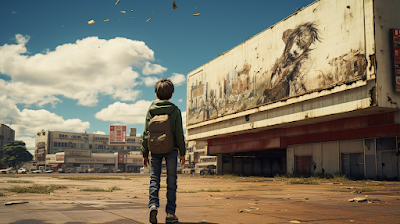It's a Human Thing; You Wouldn't Understand
I've been pondering a blog about artistic AI, but I'm still formulating my opinion. I'm using Midjourney for many of the illustrations you see on the covers of my books (and in this blog), most with some degree of Photoshop enhancement or alteration (in the image above, I distorted the imagery on the boy's jacket, as it seemed oddly infantile for the individual and setting). I created this moody image with the prompt, a scared 12 year old boy wandering down a muddy dirt street in a rundown deserted town at night, oil painting, in the style of Simon Stalenhag, muted colors, foreboding, high resolution 8k. With any of these programs, its all about the wording, which is a challenge in itself. Those who are getting the best out of MidJourney are those best educated on artists and styles. For those of us that aren't, it's an interesting educational exercise. I have to admit: I'm addicted to the platform.
Am I stealing work from artists? I don't think so. This is akin to the licensed music, videos and photos I use an my work as a corporate video producer. I certainly couldn't afford to hire an artist to create all of these images, just as I couldn't hire an orchestra or photographic to create an image of a city skyline at night.
If I were to create a graphic novel, however, I wouldn't consider AI for numerous reasons. First, maintaining consistent characters from image to image is difficult. Secondly, creating a horror-oriented graphic novel would certainly run afoul of the standards built into these programs (for example, I can't ask for anyone to be "bloody" in Midjourney). Finally, and more profoundly, AI can create images "in the style of" numerous artists, but by its nature, it doesn't have a style of its own. A human will bring in their experience as an artist and as a human being.
As for OpenAI's ChatGPT platform, a hot topic at the moment, I'm not very impressed with its fiction capabilities for many of the same reasons. It can create a recipe or write an essay or even simulate an opinion, but it lacks the human experience necessary for engaging fiction. I enjoy horror with relatable human characters. Like the Midjourney platform, ChatGPT has its own moral code. Even if I ask it to create a horror tale, it invariably formulates a happy ending.
In a recent example, I gave it the following prompt: write a horror story about a 12 year old boy who suddenly is infected with an incurable disease that makes everyone hate him intensely.
The eight-paragraph story it created told the tale of a boy who develops ugly rashes that lead to his rejection from everyone in his life. He feels totally alone. In the sixth paragraph, however, a less than clever solution: A knock came at the door. It was a delivery man, with a package for Jake. Curious, Jake dragged himself out of bed and opened the door, taking the package from the man. As he touched the man's hand, something strange happened. The delivery man's expression changed from one of disgust to one of understanding.
The last paragraph three paragraphs tie everything up in a nice bow. Jake found a friend.
Good grief.
Now, to be clear—this is an amazing technology and will certainly be useful in many other ways, but it's not the best route for fiction. I am constantly experimenting and seeing where it can take me, though. It's fun, but it had definite limitations.
I asked ChatGPT to write a Tweet for me about writing this blog: Hey everyone! Exciting news - I just published a new blog about my experience with ChatGPT. It's a fascinating AI language model that has truly blown my mind. Check it out and let me know what you think! #chatGPT #AI #blogpost
Not exactly the way I'd put it...I also asked it to give me a clever title for this blog. I don't know if I would call it clever: ChatGPT: Bringing Your Fiction to Life with AI



Comments
Post a Comment